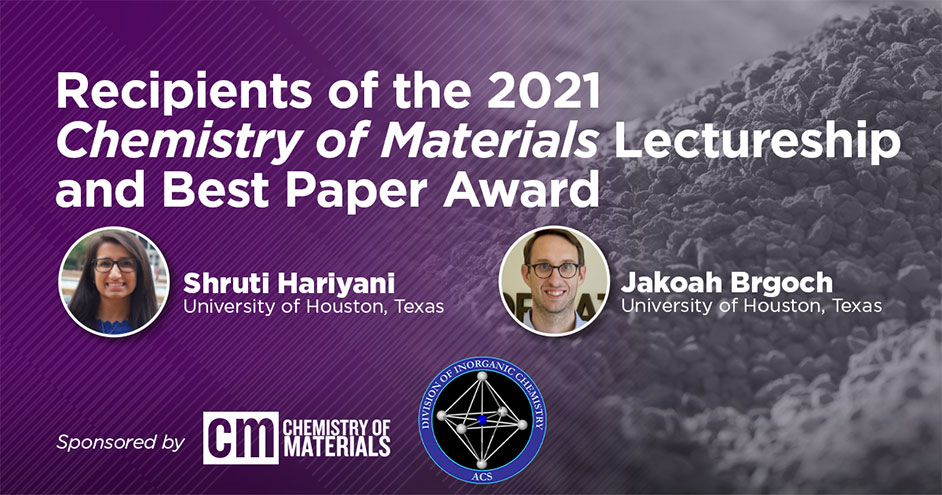Award Honors Paper with Outstanding Influence Across Field of Materials Chemistry
Shruti Hariyani, a graduate student and research assistant at the University of Houston Department of Chemistry, and Jakoah Brgoch, associate professor, have been selected as the 2021 winners of the Chemistry of Materials Lectureship and Best Paper Award.

The award, given by the journal Chemistry of Materials and the American Chemical Society Division of Inorganic Chemistry, honors the authors of an article published in 2020 that has outstanding influence across the field of materials chemistry, while also recognizing that research is a team endeavor. The Chemistry of Materials Lectureship and Best Paper Award symposium will be part of the ACS Fall National Meeting.

The winning paper, “Local Structure Distortion Induced Broad Band Emission in the All-Inorganic BaScO2F:Eu2+ Perovskite” exemplifies the power of using computation and experiment to gain a deeper understanding of how local distortions can impact a material’s properties.

“An important takeaway is that low concentrations of rare-earth dopants can affect the local structure of the host material, which should have a significant impact on the design of future phosphor materials,” said Sara E. Skrabalak, Editor-in-Chief of Chemistry of Materials.
Referencing the teamwork aspect of the award, Skrablak notes that “The nomination materials also highlighted creative problem-solving and effective mentoring as Shruti learned how to conduct advanced calculations via Zoom meetings with Professor Brgoch during laboratory shutdowns. This training has been a springboard for Shruti, who is now collaborating with other groups on understanding different phosphor systems.”
Brgoch shared his thoughts on winning this year’s lectureship and award, as well as the challenge of working together while apart.
What does winning this award mean to you?
Brgoch: It is an absolute delight to have our work selected out of so many outstanding research papers published in Chemistry of Materials. We have spent a significant amount of time trying to deepen our understanding of the fundamental structure-composition-property relationships that govern luminescent materials.
This project provided an incredible, albeit sometimes frustrating, opportunity to understand how local structure influences the optical properties. This award validates all of our efforts.
We hope that having our work highlighted by the award will encourage researchers to critically consider the importance of local structure in bulk materials. Of course, we are also grateful to have financial support for this project from the Welch Foundation and the NSF that allowed us to answer this fundamental chemistry problem.
This award is about teamwork. How did working with each other lead to the results achieved and described in your article?
Brgoch: This project started by trying to understand bizarre optical properties in what should have been a simple system. We came up with a series of synchrotron scattering experiments to address our questions, but then COVID-19 closed our lab.
Fortunately, we were able to pivot and draw on our group's background in computation to come up with a solution. Shruti is an outstanding graduate student, and we relentlessly bounced ideas off of each other while working from home to determine a possible local distortion mechanism that described exactly what we were seeing.
Other Articles by the Winning Authors:
Predicting Thermal Quenching in Inorganic Phosphors
Chem. Mater. 2020, 32, 14, 6256-6265
DOI: 10.1021/acs.chemmater.0c02231
Sr6(BO3)3BN2: An Oxido–Nitrido–Borate Phosphor Featuring BN2 Dumbbells
Chem. Mater. 2020, 32, 19, 8587-8594
DOI: 10.1021/acs.chemmater.0c02925
Ba3Y2B6O15:Ce3+— A High Symmetry, Narrow-Emitting Blue Phosphor for Wide-Gamut White Lighting
Chem. Mater. 2018, 30, 8, 2668-2675
DOI: 10.1021/acs.chemmater.8b00111
Closing the Cyan Gap Toward Full-Spectrum LED Lighting with NaMgBO3:Ce3+
Chem. Mater. 2020, 32, 2, 882-888
DOI: 10.1021/acs.chemmater.9b04739